- BOAT OF THE YEAR
- Newsletters
- Sailboat Reviews
- Boating Safety
- Sailing Totem
- Charter Resources
- Destinations
- Galley Recipes
- Living Aboard
- Sails and Rigging
- Maintenance
- Best Marine Electronics & Technology


Classic Plastic: Catalina 38
- By Michael Robertson
- Updated: June 12, 2014
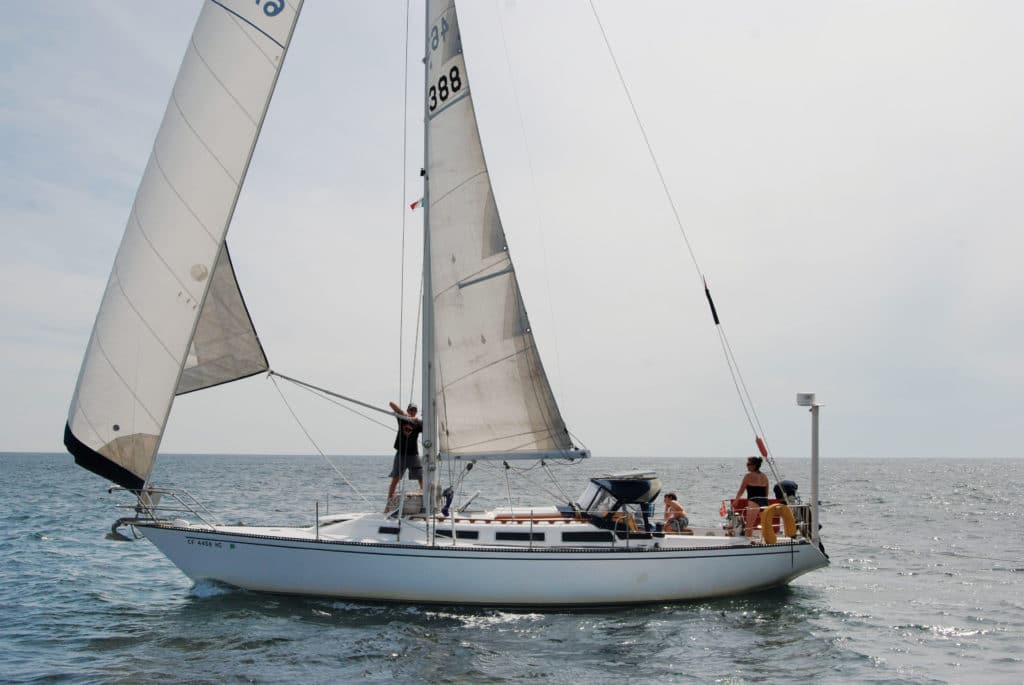
Catalina 38
In 1978, Catalina Yachts was a young company with a Midas touch, enjoying brisk sales of its sailboats from 22 to 30 feet, all of them designed and built in house. And then company owner Frank Butler tried something different. He bought the mold for the Yankee 38, designed by Sparkman & Stephens and descended from a successful one-off IOR aluminum raceboat, from the bankrupt Yankee Boat Co. Butler saw this competitive racer as a flagship that would raise the profile of the Catalina fleet. He was right. In 1980, the Catalina 38 was selected for the prestigious Congressional Cup. The company went on to build 366 Catalina 38s over the next 14 years.
Butler made significant changes to the S&S design. He replaced the skeg-hung rudder with a balanced spade rudder and created a high-aspect-ratio rig with a taller mast and shorter boom. He redesigned the interior for weekender livability and the deck and trunk cabin to match Catalina aesthetics.
Other aspects of the dated racing design — long overhangs, generous tumblehome and a pert little reverse transom — give the Catalina 38 its pleasing lines. Butler’s redesigned deck gives it a sleek, low profile but narrow side decks are a result of those changes. Passage from the cockpit to the foredeck can be tricky, especially if a wide dodger is fitted.
With its pedigree, it’s no surprise that owners report the Catalina 38 sails to windward like it’s on rails and also sails beautifully in light air. That superior upwind performance comes with a draft that approaches 7 feet, a limiting factor for some cruising sailors.
Boats designed to the IOR have a reputation for poor manners and instability downwind. But that reputation was earned under race conditions when boats were intentionally overpowered and driven hard. A cruising couple is unlikely to push any boat to the brink of broaching, and many find the IOR warhorses, including the Catalina 38, in fact make fine cruising boats.
Down below, the major interior components are incorporated into a molded hull liner. Teak trim and veneer are used for doors, drawer facings and bulkheads. In early models the cabin sole was fiberglass, but in later models it was covered with teak and holly veneer.
The keel-stepped mast abuts the bulkhead forward of the main saloon. Forward of the bulkhead are the head to port, lockers to starboard and the V-berth, which easily accommodates two adults.
A U-shaped dinette to port (that converts to a double berth) is the main feature in the saloon. Aft of the dinette is a snug U-shaped galley.
On the starboard side of the saloon is a long settee with stowage behind and beneath it. A nav station backs up to a quarter berth that extends under the cockpit.
Owners with cruising plans might find the tankage limiting, but they should avoid adding weight in the bow and stern of this fine-ended boat.
The Atomic 4 gasoline engine was fitted in very early boats but many have been replaced. The 24-horsepower Universal diesel in later ones reportedly lacks the power to push the boat at hull speed in moderate wind and chop. Engine access is adequate.
The Catalina 38 enjoys a loyal following, and owners praise its design, build quality and performance. Rare for boats of this vintage, the builder is still in business, and provides design and parts support. Asking prices range from $25,000 to $75,000, with older boats at the lower end of the bracket.
This article first appeared in the February 2014 issue of Cruising World. Click here to see more sailboats from Catalina .
- More: 31 - 40 ft , before 2000 , catalina , Coastal Cruising , monohull , Sailboat Reviews , Sailboats , sailboats classic plastic
- More Sailboats

Balance 442 “Lasai” Set to Debut

Sailboat Review: Tartan 455

Meet the Bali 5.8

Celebrating a Classic

Kirsten Neuschäfer Receives CCA Blue Water Medal

2024 Regata del Sol al Sol Registration Closing Soon

US Sailing Honors Bob Johnstone

Bitter End Expands Watersports Program
- Digital Edition
- Customer Service
- Privacy Policy
- Email Newsletters
- Cruising World
- Sailing World
- Salt Water Sportsman
- Sport Fishing
- Wakeboarding
Great choice! Your favorites are temporarily saved for this session. Sign in to save them permanently, access them on any device, and receive relevant alerts.
- Sailboat Guide
Catalina 38
Catalina 38 is a 38 ′ 1 ″ / 11.6 m monohull sailboat designed by Sparkman & Stephens and Frank V. Butler and built by Catalina Yachts between 1978 and 1990.

Rig and Sails
Auxilary power, accomodations, calculations.
The theoretical maximum speed that a displacement hull can move efficiently through the water is determined by it's waterline length and displacement. It may be unable to reach this speed if the boat is underpowered or heavily loaded, though it may exceed this speed given enough power. Read more.
Classic hull speed formula:
Hull Speed = 1.34 x √LWL
Max Speed/Length ratio = 8.26 ÷ Displacement/Length ratio .311 Hull Speed = Max Speed/Length ratio x √LWL
Sail Area / Displacement Ratio
A measure of the power of the sails relative to the weight of the boat. The higher the number, the higher the performance, but the harder the boat will be to handle. This ratio is a "non-dimensional" value that facilitates comparisons between boats of different types and sizes. Read more.
SA/D = SA ÷ (D ÷ 64) 2/3
- SA : Sail area in square feet, derived by adding the mainsail area to 100% of the foretriangle area (the lateral area above the deck between the mast and the forestay).
- D : Displacement in pounds.
Ballast / Displacement Ratio
A measure of the stability of a boat's hull that suggests how well a monohull will stand up to its sails. The ballast displacement ratio indicates how much of the weight of a boat is placed for maximum stability against capsizing and is an indicator of stiffness and resistance to capsize.
Ballast / Displacement * 100
Displacement / Length Ratio
A measure of the weight of the boat relative to it's length at the waterline. The higher a boat’s D/L ratio, the more easily it will carry a load and the more comfortable its motion will be. The lower a boat's ratio is, the less power it takes to drive the boat to its nominal hull speed or beyond. Read more.
D/L = (D ÷ 2240) ÷ (0.01 x LWL)³
- D: Displacement of the boat in pounds.
- LWL: Waterline length in feet
Comfort Ratio
This ratio assess how quickly and abruptly a boat’s hull reacts to waves in a significant seaway, these being the elements of a boat’s motion most likely to cause seasickness. Read more.
Comfort ratio = D ÷ (.65 x (.7 LWL + .3 LOA) x Beam 1.33 )
- D: Displacement of the boat in pounds
- LOA: Length overall in feet
- Beam: Width of boat at the widest point in feet
Capsize Screening Formula
This formula attempts to indicate whether a given boat might be too wide and light to readily right itself after being overturned in extreme conditions. Read more.
CSV = Beam ÷ ³√(D / 64)
Based on an earlier S&S design; (YANKEE 38-S&S #2094). The molds were purchased when Yankee Yachts went out of business. Among the modifications to the original design: new deck and coach roof, taller rig, and balanced spade rudder. Shoal draft version: 4.90’/1.49m
Embed this page on your own website by copying and pasting this code.
Discover Related Sailboats

- About Sailboat Guide
©2024 Sea Time Tech, LLC
This site is protected by reCAPTCHA and the Google Privacy Policy and Terms of Service apply.
Catalina 38
The Catalina 38 is a popular and well-regarded sailboat known for its exceptional performance and comfortable cruising capabilities. Designed by Sparkman & Stephens and built by Catalina Yachts, this classic yacht has earned a reputation for its excellent sailing characteristics and timeless design. With a length overall of 38 feet and a moderate displacement, the Catalina 38 strikes a balance between speed and stability, making it suitable for both racing and long-distance cruising.
The Catalina 38 features a spacious and well-appointed interior that offers ample accommodation for extended voyages. Its layout typically includes a comfortable salon with a dining area, a fully equipped galley, and a navigation station. The yacht offers generous headroom throughout, enhancing the sense of space and comfort on board. The cabin layout usually consists of a forward cabin with a double berth, a large aft cabin, and a well-designed head compartment. The Catalina 38's interior design emphasizes functionality and practicality, ensuring a pleasant living experience for both short trips and extended stays aboard.
On the water, the Catalina 38 excels with its impressive performance capabilities. Its sleek hull design, coupled with a well-balanced sail plan, allows for swift and agile sailing. The boat's manageable size makes it easy to handle, even for smaller crews or single-handed sailing. The Catalina 38 is often praised for its excellent upwind performance and responsiveness to the helm, providing a thrilling sailing experience. Whether you're racing competitively or embarking on a leisurely cruise, the Catalina 38 delivers a delightful combination of speed, comfort, and seaworthiness.
LOA: 38.08 ft LWL: 30.25 ft Beam: 11.83 ft Draft: 6.80 ft Displacement: 15900.00 lbs Ballast: 6850.00 lbs Hull type: Fin w/spade rudder Hull construction: FG Rigging type: Masthead Sloop
Catalina 38 for sale in the last 12 months
Below you'll find the latest Catalina 38 listings for the last 12 months. We compare the listing price with boats listed in the past and the color coding indicates if the price is good (green = below the average listing price) or more on the expensive side (red = seller is asking more than the average listing price).
Catalina 38 listing prices over time
Listing details.
Catalina 38 Press in Crusingworld
Catalina 38 international association, featured c38.
- New Sailboats
- Sailboats 21-30ft
- Sailboats 31-35ft
- Sailboats 36-40ft
- Sailboats Over 40ft
- Sailboats Under 21feet
- used_sailboats
- Apps and Computer Programs
- Communications
- Fishfinders
- Handheld Electronics
- Plotters MFDS Rradar
- Wind, Speed & Depth Instruments
- Anchoring Mooring
- Running Rigging
- Sails Canvas
- Standing Rigging
- Diesel Engines
- Off Grid Energy
- Cleaning Waxing
- DIY Projects
- Repair, Tools & Materials
- Spare Parts
- Tools & Gadgets
- Cabin Comfort
- Ventilation
- Footwear Apparel
- Foul Weather Gear
- Mailport & PS Advisor
- Inside Practical Sailor Blog
- Activate My Web Access
- Reset Password
- Pay My Bill
- Customer Service

- Free Newsletter
- Give a Gift

How to Sell Your Boat

Cal 2-46: A Venerable Lapworth Design Brought Up to Date

Rhumb Lines: Show Highlights from Annapolis

Open Transom Pros and Cons

Leaping Into Lithium

The Importance of Sea State in Weather Planning

Do-it-yourself Electrical System Survey and Inspection

Install a Standalone Sounder Without Drilling

When Should We Retire Dyneema Stays and Running Rigging?

Rethinking MOB Prevention

Top-notch Wind Indicators

The Everlasting Multihull Trampoline

Check Your Shorepower System for Hidden Dangers

How Dangerous is Your Shore Power?

DIY survey of boat solar and wind turbine systems

What’s Involved in Setting Up a Lithium Battery System?


The Scraper-only Approach to Bottom Paint Removal

Can You Recoat Dyneema?

Gonytia Hot Knife Proves its Mettle

How to Handle the Head

The Day Sailor’s First-Aid Kit

Choosing and Securing Seat Cushions

Cockpit Drains on Race Boats

Re-sealing the Seams on Waterproof Fabrics

Safer Sailing: Add Leg Loops to Your Harness

Waxing and Polishing Your Boat

Reducing Engine Room Noise

Tricks and Tips to Forming Do-it-yourself Rigging Terminals

Marine Toilet Maintenance Tips

Learning to Live with Plastic Boat Bits
- Sailboat Reviews
Morgan 38/382
Charlie morgan's hurrah becomes ted brewer's success story becomes today's pseudo-classic..
We receive many requests from readers to review certain boats. Almost without exception, the requests come from owners of the boat suggested. Few boats have been the object of more requests than the venerable Morgan 38. At first blush, it is difficult to determine which Morgan 38 we ought to address, as two distinct designs were built since the first one appeared 22 years ago. After some thought, we decided to trace the history of both as best we could, including also the Morgan 382, 383 and 384.
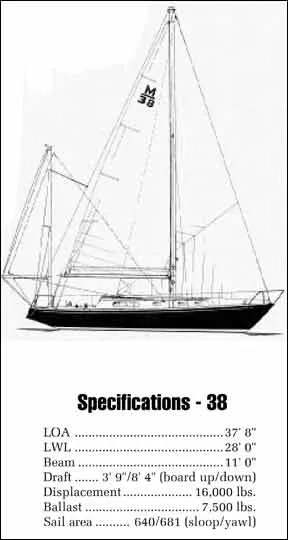
The Morgan 38 was designed in 1969 by Charlie Morgan. He had founded Morgan Yacht Company in St. Petersburg, Florida, in 1965. The Morgan 34 was his first production model. A hometown boy, he had made a name for himself in the 1960 and 1961 Southern Ocean Racing Conference (SORC), winning with a boat of his own design called Paper Tiger . While not a formally trained naval architect, Morgan demonstrated his skill with a variety of designs. Many of these were keel/centerboard models, owing to the shoalness of Florida waters. Seventy-nine were built before production halted in 1971.
In 1977, the Morgan 382 was introduced, designed by Ted Brewer, Jack Corey and the Morgan Design Team. According to Brewer, the boat was loosely based on the Nelson/Marek-designed Morgan 36 IOR One Ton. The most obvious difference between the 38 and 382 was the elimination of the centerboard and the addition of a cruising fin keel (NACA 64 012 foil) with skeg-mounted rudder. They are two completely different designs from two different eras in yacht design.
In 1980, the 382 was given a taller rig and called the 383. About 1983 the boat underwent other subtle changes, now called the Morgan 384. The rudder was enlarged and the interior modified. In its three versions, the Brewer model registered about 500 sales.
The company changed ownership several times during this period. It went public in 1968, was later bought by Beatrice Foods and then Thor Industries. Presently it is owned by Catalina Yachts, who built just 24 38s (three were kits) before discontinuing production in 1986.
The first Morgan 38 was a development of the highly successful 34, which Morgan called a “beamy, keelcenterboard, CCA (Cruising Club of America)-style of yacht. We had a good thing going and didn’t want to deviate; we found little interest in those days in keel boats. Centerboards have their own sorts of problems, but there’s an awful lot of thin water in the world, and safe refuge and quiet anchorages are mostly in shoal water.”
The boat has a long, shoal keel drawing just 3′ 9″ with the board up. The rudder is attached and there is an aperture for the propeller. “Beamy,” in 1969, meant 11 feet. The waterline was fairly short at 28 feet, but the overhangs give the hull a very balanced and pleasing profile. The stern is pure Charlie Morgan—a finely proportioned shape that is neither too big nor too small. In profile, the angle between the stern (which interestingly is a continuation of the line of the backstay) and the counter is nearly 90 degrees. It’s a trademark look.
Sloop and yawl rigs were offered, which was typical of CCA designs. The rig has a lower aspect ratio (the proportion of the hoist to the foot of the mainsail) than later designs, including the Brewer-designed 382. Yet this is a very wholesome rig for cruising. Owners responding to our questionnaire said the boat balances very well.
Owners of the 382 and subsequent permutations seemed less pleased. They didn’t rate balance as highly, noting most frequently the difficulty in tracking (keeping the boat on a straight course) when sailing off the wind (not uncommon with beamy fin keel designs; it’s a trade-off with speed, pointing ability and maneuverability). Others said that they raked their masts forward to improve balance. One thought the problem was caused because the rudder was slightly undersized. Still, these owners liked the way their boats sail.
The rig, of course, isn’t the only difference between the Morgan and Brewer designs. The latter has a foot wider beam—12 feet—and a longer waterline. Two keels were offered, the standard five-foot draft and an optional deep keel of six feet. Displacement jumped a thousand pounds to 17,000 despite a reduction in ballast from 7,500 pounds to 6,600 pounds. Centerboard boats, naturally, require more ballast because it isn’t placed as low as it is in a deep fin keel boat.
The look of the 382 is much more contemporary. The rake of the bow is straighter, as is the counter, which is shorter than the original 38 as well. Freeboard is higher and the windows in the main cabin are squared off for a crisper appearance.
Construction
The hulls of the early 38s were built of solid fiberglass and the decks of sandwich construction. Some 382 hulls were cored, others not. A variety of core materials were used, mostly Airex foam. The lamination schedule was your basic mat and woven roving, with Coremat added as a veil cloth to prevent printthrough.
Both designs have internal lead ballast, sealed on top with fiberglass.
The early 382s did not have the aft bulkhead in the head fiberglassed to the hull, which resulted in the mast pushing the keel down. All boats “work” under load, and bulkheads bonded to the hull are essential to a stiff structure. Anyone who has a boat in which major load-bearing bulkheads are not attached to the hull should do so before going offshore. To its credit, the company launched a major recall program.
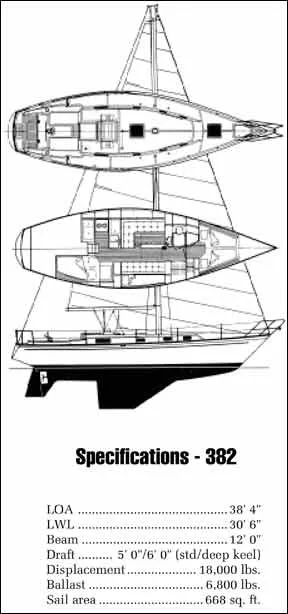
The owners of all Morgan 38s, as a group, note the strength of the boat. One said he hit a rock at 6 ½ knots and suffered only minor damage. Very few problems were mentioned. The owner of a 1981 model, however, said he “drilled through hull at waterline and was surprised at thinness of glass on either side of the Airex: 1/8” inside, 1/16″ outside.” With the stiffness that sandwich construction provides, not as much glass is required; still, protection from collision and abrasion would recommend greater thickness outside. Brewer, incidentally, discounted the report.
Interestingly, Hetron-brand fire-retardant resin was used for a time, prior to 1984; if you recall, this was blamed for the many cases of reported blistering on the early Valiant 40s. About half of the 382 owners responding to our surveys reported some blistering, none serious.
The attached rudder of the early 38 is stronger than the skeg-mounted rudder of later models. But we do prefer the skeg configuration to a spade rudder, at least for cruising. A problem with skegs, however, is the difficulty in attaching them strongly to the hull. One owner said his was damaged in a collision with a humpback whale, but that is hardly normal usage!
Several owners of later models commented that the mast was a “utility pole,” recommending a custom tapered spar for those inclined to bear the expense.
Other problems reported in our survey were only minor and were corrected by the company. In fact, owners were nearly unanimous in their praise for Morgan Yachts’ customer service.
The layout of the Morgan 38 is quite conventional and workable. In both incarnations there are Vberths forward, private head with shower (separate enclosure in the 382), dinette in main cabin with settee, galley aft in the port quarter area and nav station with quarter berth opposite to starboard. Specifications for the first 38s included “attractive wood-grained mica bulkhead paneling, with oiled American walnut trim.” This was a popular treatment in the 1960s, and practical, but often done to excess. By the 1980s, fake teak didn’t play so well. Owners wanted real wood, and that’s what they got in the 382.
Owners of early 38s complained of poor ventilation (“I added six opening ports, and would like an additional center cabin hatch,” wrote one), short Vberths (“Could be 4″ longer, but I’m 6′ 2.””), and more closet space (from a live-aboard).
Owners of later models mentioned the need for a larger forward hatch to get sails through, a hatch over the galley, larger cockpit scuppers, and Dorade vents.
(Teak Dorade boxes were added on the 384.) They complained of not enough footroom in the V-berths and poor location of the main traveler in the cockpit. (The traveler was moved to the cabinhouse top on the 384.)
Despite these minuses, most owners cite the volume of the interior and many stowage compartments as major reasons for their satisfaction with the boat.
Performance Under Sail
As implied in our comments on balance in the “Design” section of this review, the centerboard 38 sailed beautifully. She is dry and seakindly, stable and relatively fast for her generation. Its PHRF rating ranges from 145 to about 150. The yawl rig is probably not as fast as the sloop, but for the cruising couple, the mizzen sail gives the skipper another means of balancing the boat, as well as a means to fly more sail when reaching if he’s prepared to fuss with a staysail.
The 382 rates between 128 and 150, about 137 on average. The Morgan 383 and 384, which are grouped together, rate a mite lower at 135, on average.
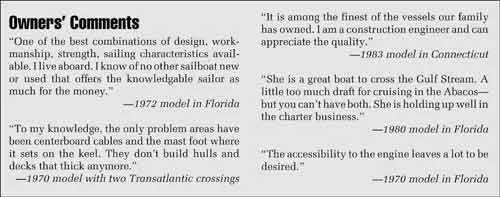
It is not surprising that Brewer’s redesign is faster, even though it’s 1,000-2,000 pounds heavier. This is due to it’s deeper fin and higher aspect rig with the ability to carry larger headsails. There is also less wetted surface. Performance Under Power
The centerboard 38 was powered by the seemingly ageless Atomic Four gasoline engine, though a Perkins 4-107 or Westerbeke 4-107 was available at extra cost ($1,940 in 1969). The early 38s cruise at about 6 ½ knots.
A first-generation Yanmar—the 3QM30—was used on some 382s, and as owners of those engines know, they tend to be noisy and vibrate a great deal. Yanmar engines improved a great deal after the manufacturer redesigned and retooled the entire line. But the most common powerplant was the magnificent 50-horsepower Perkins 4-108. If we were looking for a Morgan 38 to purchase, we’d certainly lean toward one with this engine.
Both designs handle reasonably well under power, as well as most sailboats do, meaning that backing down with a two-blade prop is a necessarily cautious procedure.
A number of owners recommend changing to a three-blade prop, but that will affect sailing performance. One should examine his sailing style closely before making the move.
The Morgan 38, in any incarnation, is a handsome boat that sails well and is built strong enough for most people’s purposes. Some may pause before taking a centerboard boat far offshore, but it has certainly been done—recall, if you will, Carleton Mitchell’s hugely successful racer Finnisterre .
Both centerboard and fin keel versions seem to us to have advantages and disadvantages that are essentially tradeoffs.
On the one hand, we like an attached rudder for cruising, as it provides the best protection from collision with logs and other hard objects. On the other, we recognize the importance of placing ballast low, as in the fin keel version, and we appreciate
Brewer for giving a nice slope to its leading edge so that damage from hitting logs will be minimized. Brewer said that a 382 that passes survey is capable of cruising just about anywhere. “They’ve crossed oceans,” he said.
To our eye, we admit to being fond of the CCA designs with low freeboard and graceful sheer lines. The yawl is a versatile rig that is especially attractive, though it does require more in the way of tuning and maintenance.
An early Morgan 38, in good condition, should sell in the high 20s. Expect to pay a thousand or so more for the yawl. For sellers, considering that in 1969 the base price of the boat was $22,995, that’s not a bad return on investment.
Fifteen years later the price had jumped to $84,995 (1984 model). Those boats today are advertised in the mid to high 60s, and occasionally the low 70s. (What anyone is actually getting for these days is another matter entirely).
Considering the changes in the economy, that’s still not bad performance. What it means most to the prospective buyer is that the Morgan 38 and 382 are popular, much admired boats that should, we expect, hold their value as well as or better than most others.
RELATED ARTICLES MORE FROM AUTHOR
My husband & I bought a 382 Morgan in 1980. Named her Galewynd. We enjoyed her til we sold in 2000
My husband & I bought a 382 in 1980. We named her Galewynd. We enjoyed her til we sold in 2000
LEAVE A REPLY Cancel reply
Log in to leave a comment
Latest Videos

40-Footer Boat Tours – With Some Big Surprises! | Boat Tour

Electrical Do’s and Don’ts

Bahamas Travel Advisory: Cause for Concern?

Island Packet 370: What You Should Know | Boat Review
- Privacy Policy
- Do Not Sell My Personal Information
- Online Account Activation
- Privacy Manager
CATALINA 38 Detailed Review
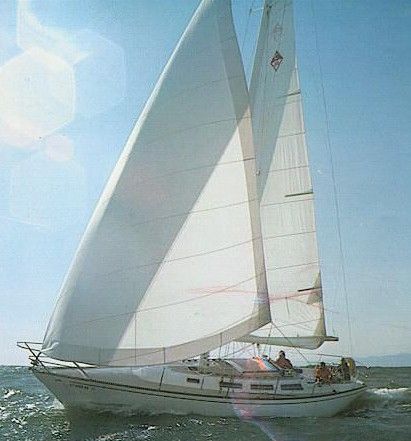
If you are a boat enthusiast looking to get more information on specs, built, make, etc. of different boats, then here is a complete review of CATALINA 38. Built by Catalina Yachts and designed by Sparkman & Stephens, the boat was first built in 1978. It has a hull type of Fin w/spade rudder and LOA is 11.61. Its sail area/displacement ratio 16.28. Its auxiliary power tank, manufactured by Universal, runs on Gas.
CATALINA 38 has retained its value as a result of superior building, a solid reputation, and a devoted owner base. Read on to find out more about CATALINA 38 and decide if it is a fit for your boating needs.
Boat Information
Boat specifications, sail boat calculation, rig and sail specs, auxillary power tank, accomodations, contributions, who designed the catalina 38.
CATALINA 38 was designed by Sparkman & Stephens.
Who builds CATALINA 38?
CATALINA 38 is built by Catalina Yachts.
When was CATALINA 38 first built?
CATALINA 38 was first built in 1978.
How long is CATALINA 38?
CATALINA 38 is 9.22 m in length.
What is mast height on CATALINA 38?
CATALINA 38 has a mast height of 13.41 m.
Member Boats at HarborMoor
Catalina 380
The catalina 380 is a 38.42ft masthead sloop designed by g. douglas / catalina and built in fiberglass by catalina yachts since 1997..
The Catalina 380 is a moderate weight sailboat which is a reasonably good performer. It is stable / stiff and has a good righting capability if capsized. It is best suited as a bluewater cruising boat. The fuel capacity is originally small. There is a good water supply range.
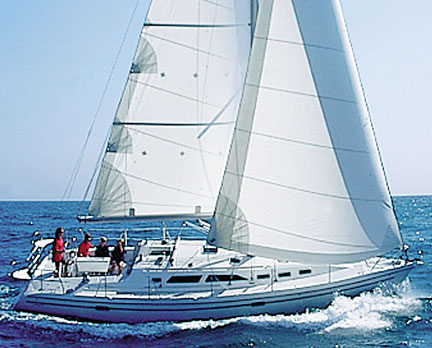
Catalina 380 for sale elsewhere on the web:

Main features
Login or register to personnalize this screen.
You will be able to pin external links of your choice.

See how Sailboatlab works in video

We help you build your own hydraulic steering system - Lecomble & Schmitt
Accommodations
Builder data, other photos.
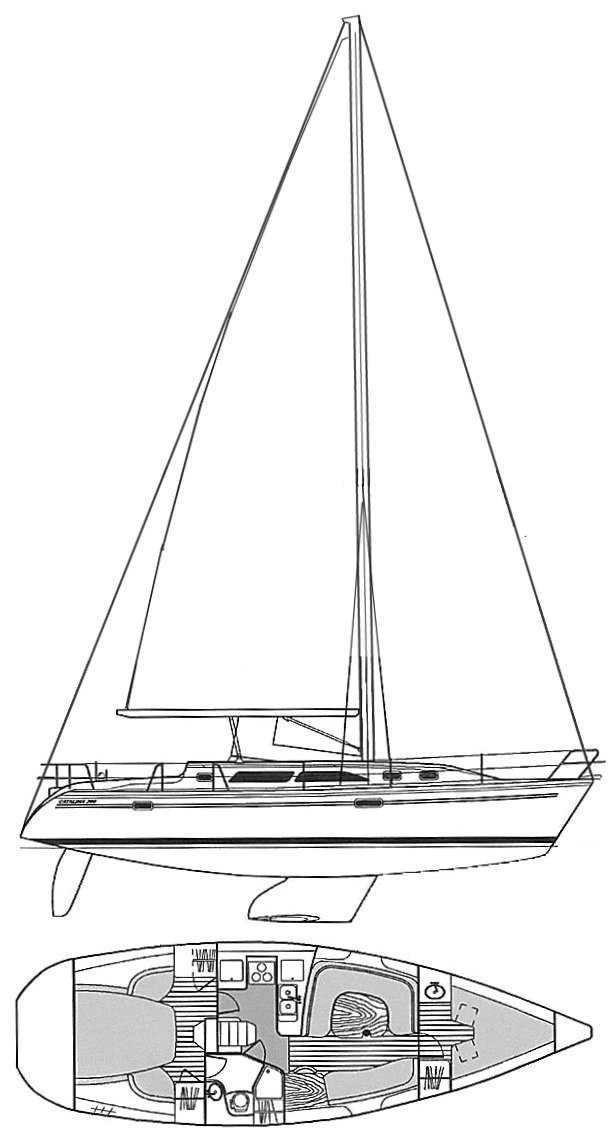
Modal Title
The content of your modal.
Personalize your sailboat data sheet
× You are using an outdated browser. Please upgrade your browser to improve your experience.
We Ship Worldwide! | FREE SHIPPING! for US Continental orders over $99. Click for details.

Shopping Cart
Your cart is currently empty..
FREE SHIPPING! for US Continental orders over $99 click for details
Catalina - Sailboat Data, Parts & Rigging
Sailboat data directory for sailboats manufacturer or named Catalina. Follow the provided links for additional sailboat data, parts and rigging specs.
Sailboat Data directory for over 8,000 sailboat designs and manufacturers. Direct access to halyards lengths, recommended sail areas, mainsail cover styles, standing rigging fittings, and lots more for all cruising and racing sailboats.
MAURIPRO Sailing offers a full range of sailboat and sailing information to help you find the correct sailboat part, one that properly would fit your sailboat and sailing style. Our sailor's and sailboat owner support team are ready to talk with you about your specific sailing needs, coming regatta, or next sailing adventure.
From all at MAURIPRO, let's Go Sailing!
Copyright © 2024 MAURIPRO Sailing LLC.

IMAGES
COMMENTS
Based on an earlier S&S design; (YANKEE 38-S&S #2094). The molds were purchased when Yankee Yachts went out of business. Among the modifications to the original design: new deck and coach roof, taller rig, and balanced spade rudder. Shoal draft version: 4.90'/1.49m.
There is a Yankee 38 named Bullet berthed in Shelton, WA. Also, a Catalina 38 owner reported that an infamous Yankee 38 called Damn Yankee can be found in Olympia, WA as well. It is a well known boat (hull #4 or 5) and can be found next to his Catalina 38, "Cyrena"! Frank Butler of Catalina Yachts purchased the molds from Yankee, and ...
The Catalina 38 enjoys a loyal following, and owners praise its design, build quality and performance. Rare for boats of this vintage, the builder is still in business, and provides design and parts support. Asking prices range from $25,000 to $75,000, with older boats at the lower end of the bracket. Advertisement.
The Catalina 38 is an American sailboat that was designed by Sparkman & Stephens as a racer-cruiser and first built in 1978. The Catalina 38 is a development of the Yankee 38. Production. The design was built by Catalina Yachts in the United States. The company built 365 examples between 1978 and 1990, but it is now out of production.
Discover Related Sailboats. Sailboat. 1972 • 38′ 1″. Catalina 38 is a 38′ 1″ / 11.6 m monohull sailboat designed by Sparkman & Stephens and Frank V. Butler and built by Catalina Yachts between 1978 and 1990.
The Catalina 38 is a 38.08ft masthead sloop designed by Sparkman & Stephens / Butler and built in fiberglass by Catalina Yachts between 1978 and 1990. 365 units have been built. The Catalina 38 is a moderate weight sailboat which is a reasonably good performer. It is very stable / stiff and has a good righting capability if capsized.
Catalina 38 Owners. Related Sailboats: 1 Sailboats / Per Page: 25 / Page: 1. 0 CLICK to COMPARE . MODEL LOA FIRST BUILT FAVORITE COMPARE; CATALINA 38: 38.08 ft / 11.61 m: 1978: ShipCanvas. KiwiGrip. Bruntons. Rudder Craft. EWOL. SBD App Non-BR ...
The Catalina 38 is much sought-after by used sailboat buyers; this 1986 model is currently listed on YachtWorld. Design, Construction and Performance. This boat was designed as a racer by Sparkman & Stephens and was originally put into production and sold as the Yankee 38.
The Catalina 38's interior design emphasizes functionality and practicality, ensuring a pleasant living experience for both short trips and extended stays aboard. On the water, the Catalina 38 excels with its impressive performance capabilities. Its sleek hull design, coupled with a well-balanced sail plan, allows for swift and agile sailing.
The site is made possible through the volunteer efforts of Catalina 38 International Association members, to promote the value of Catalina 38 ownership. The Association also sponsors the annual Catalina 38 Nationals, a one design race which keeps our racing heritage alive. We need the support of all Catalina 38 owners in order to create ...
Presently it is owned by Catalina Yachts, who built just 24 38s (three were kits) before discontinuing production in 1986. Design. The first Morgan 38 was a development of the highly successful 34, which Morgan called a "beamy, keelcenterboard, CCA (Cruising Club of America)-style of yacht.
Complete Sail Plan Data for the Catalina 38 Sail Data. Sailrite offers free rig and sail dimensions with featured products and canvas kits that fit the boat. ... Sailboat Data ; Catalina 38 Sail Data ; Catalina 38 Sail Data. Pinit. SKU: X-SD-4442 . Quantity discounts available . Quantity Price; Quantity -+ Add to Cart . Details. Details ...
Sailboat data, rig dimensions and recommended sail areas for Catalina 38 sailboat. Tech info about rigging, halyards, sheets, mainsail covers and more. Sailboat Data directory for over 8,000 sailboat designs and manufacturers. Direct access to halyards lengths, recommended sail areas, mainsail cover styles, standing rigging fittings, and lots ...
CATALINA 38 Detailed Review. 1 of 1. If you are a boat enthusiast looking to get more information on specs, built, make, etc. of different boats, then here is a complete review of CATALINA 38. Built by Catalina Yachts and designed by Sparkman & Stephens, the boat was first built in 1978. It has a hull type of Fin w/spade rudder and LOA is 11.61.
Although a bit higher priced than other 38-footers of this age and quality, the Catalina/Morgan 38 offers a practical layout that is appreciated by live-aboard, coastal cruisers. If these are your sailing and cruising plans, this is a boat that deserves serious consideration. Reviewed in the March 2007 issue of SpinSheet by Jack Hornor.
1986 Catalina 38. US$47,500. Seattle Yachts | Los Angeles, California. US$36,000. <. 1. >. * Price displayed is based on today's currency conversion rate of the listed sales price. Boats Group does not guarantee the accuracy of conversion rates and rates may differ than those provided by financial institutions at the time of transaction.
The Catalina 380 is a 38.42ft masthead sloop designed by G. Douglas / Catalina and built in fiberglass by Catalina Yachts since 1997. The Catalina 380 is a moderate weight sailboat which is a reasonably good performer. It is stable / stiff and has a good righting capability if capsized. It is best suited as a bluewater cruising boat.
Sailboat data directory for sailboats manufacturer or named C atalina. Follow the provided links for additional Sailboat data, parts and rigging specs. ... Catalina 38. Catalina 380. Catalina 385. Catalina 387. Catalina 390. Catalina 400 MKII. Catalina 42. Catalina 42 MKII. Catalina 445. Catalina 470. Catalina Morgan 43. Catalina Morgan 440 ...